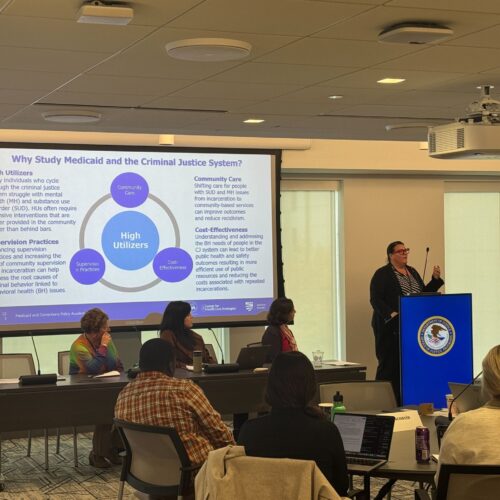
As leaders and people impacted by the criminal justice system work to improve outcomes for people leaving prisons and jails, one fact has become clear: access to stable, affordable housing is a critical component of reentry, and it is highly effective at preventing future involvement in the justice system. However, despite the importance of housing in reducing recidivism, the supply of affordable housing continues to be limited nationwide. Additionally, people leaving prisons and jails often face barriers to accessing available housing due to stigma and criminal record restrictions. To offset these issues, reentry coordinators, discharge planners, and other justice system partners must develop partnerships with their local homeless and housing assistance systems—particularly with their community’s Continuum of Care (CoC)—to help connect people in reentry with vital housing options. Here are answers to four frequently asked questions about building effective partnerships with CoCs.
1. What are CoCs, and why are they such important partners?
A CoC is a local planning entity that receives homeless assistance funding for housing and supportive services from the U.S. Department of Housing and Urban Development (HUD). CoCs are led by a board that typically consists of representatives from housing and homeless service agencies, behavioral health providers, government officials, and other key community partners. Nearly every community in the U.S. is covered by a CoC, whose jurisdictions may be at the state/regional, county, or municipal level. Key CoC responsibilities include prioritizing housing and services projects for funding, as well as coordinating housing and shelter placements. CoCs are some of the largest sources of homeless assistance funding in many communities, including for key permanent housing options such as permanent supportive housing and rapid re-housing. Due to these dual prioritization and funding roles, CoCs are uniquely positioned to help local criminal justice leaders connect people with housing and services as they are preparing for reentry.
2. How does a CoC prioritize people for housing assistance?
HUD requires that CoCs maintain a Coordinated Entry system, a community-wide infrastructure that governs access to all homeless assistance resources under the CoC’s jurisdiction. The main functions of this system are to provide a standardized intake and assessment process to evaluate housing and service needs, as well as to use a uniform set of written standards to prioritize people for assistance. Intake into the system can happen at different access points, which typically include agencies such as shelters or behavioral health providers, mobile outreach teams, and community hotlines, but can include jails and prisons as well.
HUD encourages communities to consider a broad range of prioritization criteria in their written standards, including a history of high use of emergency/crisis system resources such as jails. However, both HUD’s definition of homelessness and its focus on serving people who are considered chronically homeless can make it difficult for some people to qualify for CoC assistance—in particular, permanent supportive housing, after long periods of incarceration.
3. How can criminal justice leaders build or strengthen a partnership with their community’s CoC?
While it can be challenging for CoCs to prioritize people leaving prison and jail among the many individuals in need of assistance, a helpful strategy for criminal justice leaders looking to begin engagement with their community’s CoC is to emphasize the significant overlap in populations served by both systems. In addition, justice and CoC partners can work together in a number of concrete ways to increase housing opportunities for people in reentry. For example, corrections leaders can devote resources to creating Coordinated Entry access points, enabling discharge planning staff to conduct needs assessments and make housing and service referrals while people are still in prison or jail. Justice system agencies can also provide valuable resources to augment those available from the CoC directly, such as short-term rental subsidies, assistance with moving costs, and housing search and stabilization services. These resources can be especially useful in serving people not typically prioritized by HUD-funded programs, while still utilizing the Coordinated Entry infrastructure for assessment, prioritization, and referral. Most importantly, justice system leaders should focus on maintaining and strengthening their CoC partnerships over time (for example, by joining the CoC board), as these ongoing relationships can help inform long-term prioritization and resource allocation decisions.
4. How have communities built effective CoC and criminal justice system partnerships?
• In Cuyahoga County, Ohio, a cross-system team led by the Common Pleas Court and the Alcohol, Drug, and Mental Health Services Board has utilized state funding to create 15 units of permanent supportive housing for people preparing for reentry who have a history of frequent jail, hospital, or shelter use. The CoC was instrumental in the planning process for this initiative and provides ongoing programmatic support.
• According to officials in Albany, New York, the CoC used funding reallocated from other projects to develop six housing units to be used as rapid re-housing for people recently discharged from prison. This program provides case management to assist in housing retention, connection to employment opportunities, and the transition to private market housing.
To learn more about the role of cross-system partnerships in increasing housing options for people leaving prison and jail, visit Action Points: Four Steps to Expand Access to Housing for People in the Justice System with Behavioral Health Needs. Also, join us on April 27, 2022, for Building Effective Partnerships with Continuums of Care to Increase Housing Options for People Leaving Prisons and Jails—a webinar hosted by the CSG Justice Center, the National Reentry Resource Center, and the U.S. Department of Justice’s Bureau of Justice Assistance for Second Chance Month.
©Photo by Kimson Doan on Unsplash
This project was supported by Grant No. 2020-CZ-BX-K001 awarded by the Bureau of Justice Assistance. The Bureau of Justice Assistance is a component of the Department of Justice’s Office of Justice Programs, which also includes the Bureau of Justice Statistics, the National Institute of Justice, the Office of Juvenile Justice and Delinquency Prevention, the Office for Victims of Crime, and the SMART Office. Points of view or opinions in this document are those of the author and do not necessarily represent the official position or policies of the U.S. Department of Justice.
About the authors


When returning to their communities from criminal justice settings, people with behavioral health needs face barriers in accessing…
Read MoreNew Hampshire Department of Corrections Commissioner Helen Hanks presents at the Medicaid and Corrections Policy Academy in-person meeting.
Read MoreThe Council of State Governments (CSG) Justice Center has launched the Collaborating for Youth and Public Safety Initiative…
Read More Assigned to the Cloud Crew: The National Incarceration Association’s Hybrid Case Management for People with Behavioral Health Needs
Assigned to the Cloud Crew: The National Incarceration Association’s Hybrid Case Management for People with Behavioral Health Needs
When returning to their communities from criminal justice settings, people with behavioral health needs face barriers in accessing basic needs—including food, housing, employment, transportation, education, clothing, and substance use and mental health services—which increases their risk of experiencing a crisis.
Read More Meet the Medicaid and Corrections Policy Academy Mentor States
Meet the Medicaid and Corrections Policy Academy Mentor States
New Hampshire Department of Corrections Commissioner Helen Hanks presents at the Medicaid and Corrections Policy Academy in-person meeting.
Read More Six States Commit to Improving Statewide Strategies to Address Youth Crime, Violence and Behavioral Health
Six States Commit to Improving Statewide Strategies to Address Youth Crime, Violence and Behavioral Health
The Council of State Governments (CSG) Justice Center has launched the Collaborating for Youth and Public Safety Initiative (CYPSI) in partnership with six states: California, New Mexico, New York, Ohio, Oklahoma, and Rhode Island. The initiative will help states develop, fund, and effectively implement a research-based service continuum to improve public safety and behavioral health, education, and other outcomes for youth.
Read More Bipartisan Group of 88 Lawmakers Push for Continued Funding for Reentry and Recidivism Programs
Bipartisan Group of 88 Lawmakers Push for Continued Funding for Reentry and Recidivism Programs
A bipartisan group of 88 lawmakers, led by Representatives Carol Miller (R-WV) and Danny Davis (D-IL), wrote a letter calling for continued funding for the Second Chance Act in the Fiscal Year 2026 Commerce, Justice, Science, and Related Agencies appropriations bill.
Read More









